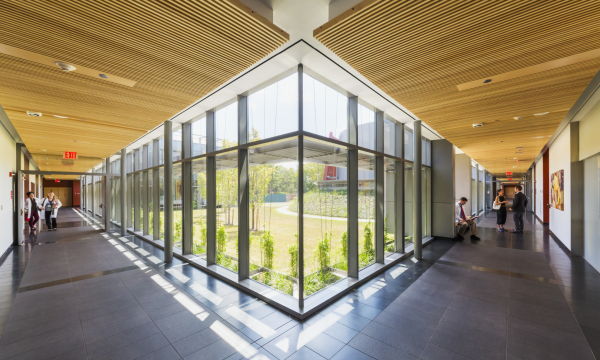
Salutogenesis is a term coined by Aaron Antonovsky, a professor of medical sociology and is derived from a mix of Greek and Latin that roughly translates to “health origins” and describes an approach focusing on factors that support human health and well-being, rather than on factors that cause disease. More specifically, the “salutogenic model” is concerned with the relationship between health, stress, and coping.
Today, there is a growing movement within the healthcare industry to incorporate Antonovsky’s salutogenic principles into the world of design. Indeed, salutogenic design is already being used to construct many of the world’s most modern hospitals. Simply put, salutogenic design aims to build structures that make people healthier and happier.
Array Architects utilized salutogenic concepts in the design of the Behavioral Health Pavilion at Zucker Hillside Hospital, part of the North Shore Long Island Jewish Health System.
The Behavioral Health Pavilion has an atypical design for a behavioral health facility, differing from the institutional look of many psychiatric care hospitals. Located in the heart of an academic medical center, the front of the building incorporates a glass curtain wall with a vine-covered truss system to create a sustainable ‘green wall’, as well as access to nature and garden spaces that serve as an area of respite for the staff. For the patients, activity courtyards are conveniently located at grade to promote exercise and socialization. The remainder of the building is clad in a fiber cement rain screen system in different colors, giving the building a striking profile on the campus.
Array developed an innovative floor plan based on the “Disney Model” – a design that provides on-stage and off-stage areas and locates support spaces adjacent to a service elevator and vestibule. This way staff can support unit needs in a safe and non-obtrusive manner from behind the scenes without physically walking onto the unit. Supporting the residential feel of the overall environment, a three-corridor system creates distinct public, patient and staff zones. This allows visitors to arrive at their destination without passing through the patient zone. Staff circulates between the patient and support zones and can go “off stage,” away from the public or patient areas to concentrate on paperwork or take a break.
The public zone includes a two-story light-filled rotunda at the entrance, which serves as a waiting area in which visitors can chat or grab a snack at the cafe. With views to nature and comfortable furniture, visitors can take a restful break. The rotunda also serves as a lounge space for students and teaching staff to meet and converse promoting the educational aspects of the institution.
The interior public corridors have floor-to-ceiling glass and a cable structure with vines to enhance the shading characteristics and lessen solar heat gain. Large scale, impactful art serves as a wayfinding device at key entry portals, complemented by soothing colors and materials that were selected in concert with the local vernacular, again reinforcing an environmental that is familiar and recognizable.
Care also was taken to maximize views to nature and natural light for patients. For instance, activity rooms and dining areas feature partial-height partitions and polycarbonate and resin walls, allowing sunlight into the central core. The 1st floor adult and adolescent units have access to an outdoor activity area with a basketball court. The 2nd floor units have enclosed terraces. Patient corridors include large pieces of art, such as landscapes, framed by benches and soffits, to give patients the feel of sitting on a porch as well as create a unique identifier to assist in finding their room.
Jon Sell, a Principal with Array and the lead planner and designer for the project, takes you on a video tour of the different salutogenic elements in the building.
Click on the link to view each video.
Installment 1: Building Organization and Planning Drivers
Installment 2: Universal Room Model and Patient Safety
Installment 3: Staff Support Areas and Safety
Installment 4: Patient Bathroom Features





